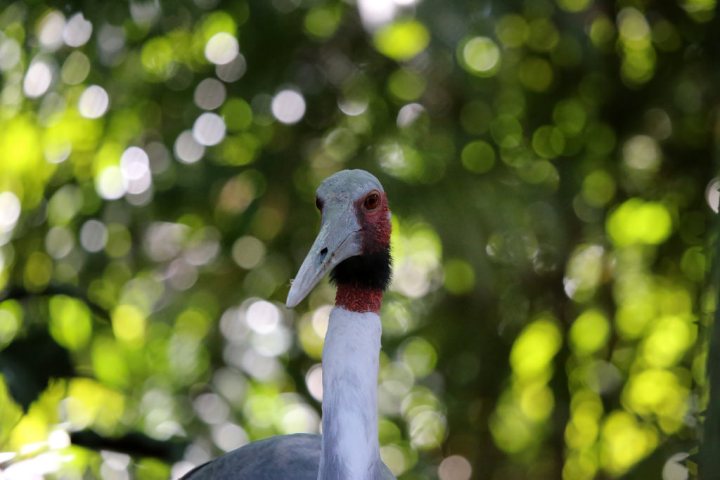Rapid development posing threat to Australia's Sarus Crane: Researchers
The researchers used some high-tech methods --- stable isotope analyses -- to peer into the dietary habits of the two crane species using molted feathers.

- Country:
- Australia
- India
Basic surveys are urgently needed across northeastern Australia to determine important areas for breeding and non-breeding cranes, including the sarus crane, especially given efforts to intensify development in the region, says a group of ornithologists that include two Indians.
In a first-of-its-kind study, the ornithologists are monitoring the breeding area of the sarus crane in northern Queensland, where it shares the area with the closely-related brolga species.
These two species are very poorly studied in Australia and this is the first-ever, systematic, 3,000 km survey to determine ecological parameters for them, Mysuru-based Nature Conservation Foundation scientist K.S. Gopi Sundar told IANS.
"We carried out a multi-floodplain landscape-scale survey during April-May 2017 and derived metrics for several ecological aspects for the first time for both crane species," he said.
Large-scale developments currently planned in this region, with potentially major impacts on cranes, create an urgent need to understand the ecological requirements of each crane species, say the biologists in a paper that will go online next month by Emu - Austral Ornithology, the flagship of BirdLife Australia that is dedicated to creating a bright future for Australia's birds.
The researchers used some high-tech methods --- stable isotope analyses -- to peer into the dietary habits of the two crane species using molted feathers.
The methods yielded some amazing new information on how the two species may be eating different things to enable their sympatry, said Sundar, also the Director of Programme SarusScape for the International Crane Foundation. (Two related species are said to be sympatric when they live in the same geographical area and often encounter each other.)
The field team, comprising two Indians -- Sundar and Swati Kittur -- and one of Finnish of Irish-origin (now both naturalised Australians) braved the remote outback along the Gulf of Carpentaria.
The collaboration included the Universities of Melbourne, New South Wales and independent crane researchers.
It is not common for scientists in India to think outside the country borders for work.
"For me, the choice was easier since the sarus is found in many countries outside of India and we need to include studies on their requirements everywhere if we are to work towards their conservation globally," Sundar explained.
The study says the abundance of the two species differed between the floodplains. Both crane species synchronised nest initiation with rainfall (November to March). Breeding success was higher than past estimates anywhere, with 60 per cent of sarus crane pairs and 50 per cent of brolga pairs fledging chicks.
The sarus crane, the globally threatened due to rapid land-use changes, including deforestation and agricultural intensification particularly in Southeast Asia, preferred four riverine eucalyptus-dominated regional ecosystems in Australia, with 10 per cent using open habitats.
The brolga preferred two non-wooded regional ecosystems, but 32 per cent shared the eucalyptus-dominated regional ecosystems with the sarus crane.
Stable isotope analyses revealed the sarus diet to comprise more diverse vegetation than the brolga, which fed across a wider range of tropical levels.
The Gilbert river floodplain had the highest counts and encounter rate of the sarus crane, while more brolgas were sighted in the Flinders river floodplain.
In India, landscape-scale occupancy of the sarus cranes estimated using roadside observations was lower relative to estimates from systematic transects in all seasons, likely due to increased human disturbance and habitat modification along roads.
However, in the Gulf of Carpentaria, burrow pits and cattle watering holes along roads were frequently used by cranes, suggesting that roadside observations may inflate the abundance estimates in some locations.
"However, these features were not uniformly distributed and the role of these artificial habitats in influencing crane distribution and abundance needs investigation," say the researchers.
A more robust assessment of abundance and understanding of factors influencing crane abundance and distribution in the Gulf is necessary, the study suggests.
Sundar said that, in Uttar Pradesh, home to the largest global population of the sarus, rainfall and territory quality mediated breeding success of the cranes, suggesting that both rainfall and changing land use will influence the Gulf of Carpentaria cranes' breeding success.
"This survey provides a high-resolution metric for the Gulf cranes for the first time," he said.
The biggest threat to the sarus crane anywhere in the world is the expansion of urban and semi-urban areas that are eating into wetlands, marshes, open lands, grasslands and even agricultural lands, he added. This permanently displaces breeding pairs and directly threatens the long-term viability of local populations.
Other threats include poisoning, mortality due to collision with electricity wires and the death of unfledged young birds due to predation by an increasing population of dogs.
The sarus cranes are rarely seen in Pakistan, and a couple of pairs used to reside in southern China but have not been seen for a while. Populations also occur in Southeast Asia.
(With inputs from agencies.)
- READ MORE ON:
- Cinema/Showbiz
- National
- Environment/Wildlife
- Ians Life News
- IANS News
ALSO READ
Pakistan Hockey Federation wants Oltmans to coach national team
Mayank Yadav can be fast-tracked into international cricket, India have got something special: Broad
Vietnam National Assembly speaker to visit China April 7-12
Tech Visionary, Venkata Mudumbai was honored with the International Achievers Award by the Indian Achievers’ Forum
SC asks Sharad Pawar faction to sensitise party workers about using name 'Nationalist Congress Party-Sharadchandra Pawar' in poll campaigns.










